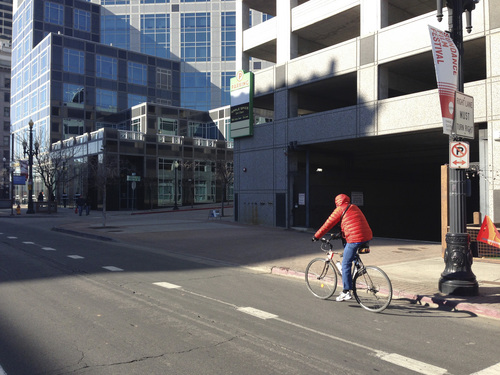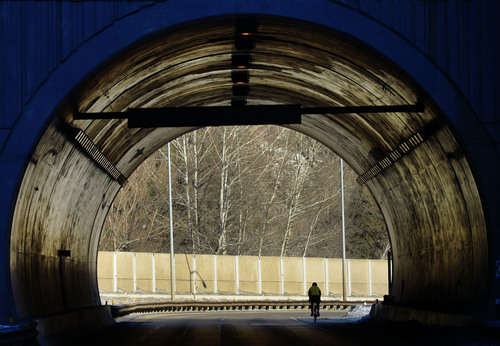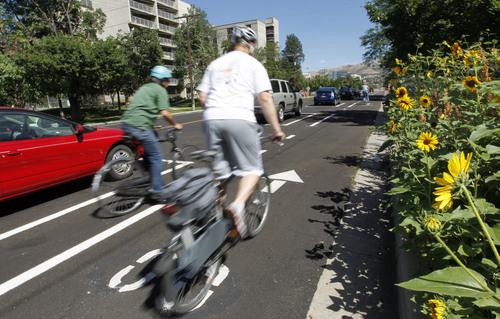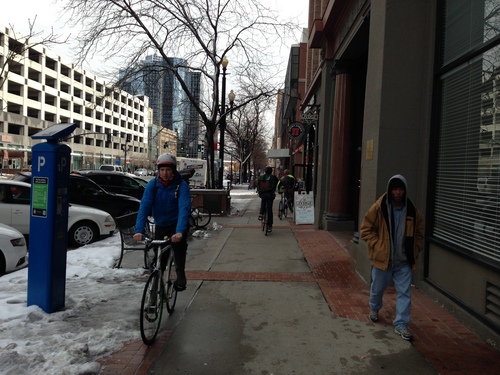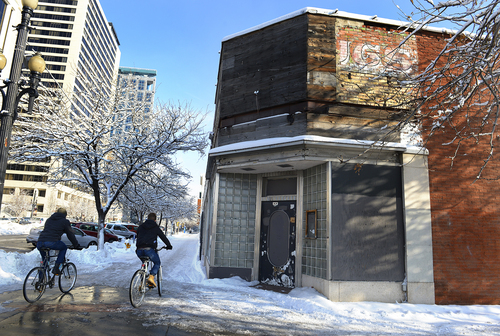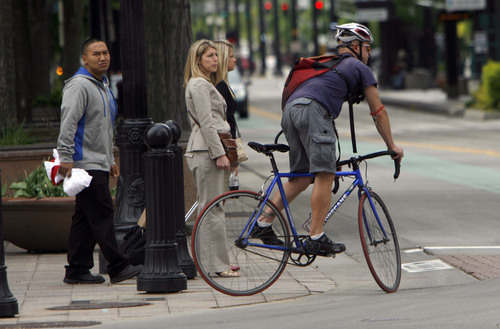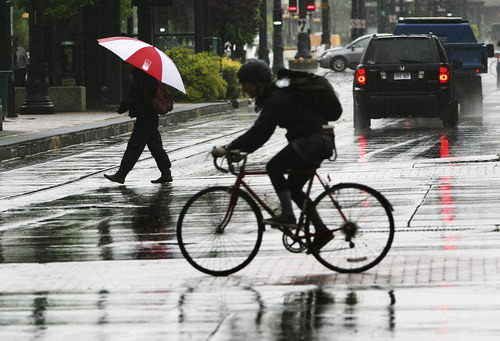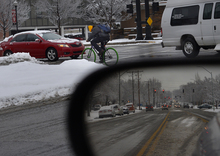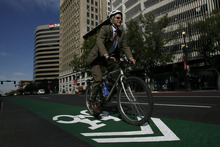This is an archived article that was published on sltrib.com in 2014, and information in the article may be outdated. It is provided only for personal research purposes and may not be reprinted.
Phillip Carlson swerved hard but the car hit him anyway.
Carlson — an avid commuter cyclist and chairman of the Salt Lake Bicycle Collective — had decided to take a recreational ride on Aug. 30, 2011. It was near the end of the ride and, as Carlson was coming down 6200 South near the Old Mill Golf Course, he began to pick up speed. As usual, Carlson was riding on the far right side of the street, in this case as it curved around and away from the foothills.
Then he saw the car. It was coming from the opposite direction but as Carlson zipped downhill, it swooped around, making a wide U-turn into Carlson's path.
He hit the brakes. His back tire blew out. He veered closer to the edge. But it didn't matter: The car and Carlson collided, throwing him to the pavement.
Carlson suffered three neck fractures from the incident. He still has pain and doctors told him he would likely have early arthritis. And his ability to move his neck has diminished.
"I don't like to say it," Carlson said, "but I was lucky. It could have been worse."
Carlson really was lucky. In the closing months of 2013 alone, The Salt Lake Tribune reported on an array of auto-bike accidents, a handful of them fatal. Many of the cyclists, such as Carlson, were seasoned riders wearing helmets, lights, even reflective clothing. They were doing everything right.
This is a story about why crashes like these happen. And where. It's a story about forgetting the old tropes of bicycle safety — helmets, lights, reflectors are still important, of course — and focusing on what may matter even more: location, location, location.
—
The anatomy of a dangerous street •So what makes some streets ripe for collisions, while others remain comparatively safe?
Salt Lake City saw 853 auto-bike collisions between January 2008 and October 2013, according to data obtained via a public records request. Add in the numbers over a slightly shorter period from cities served by Unified Police Department and the number jumps to 1,193. The highest concentration of accidents was in downtown Salt Lake City and adjacent neighborhoods.
But not every street saw the same amount of havoc. In fact, some streets, such as 700 East, saw vastly more accidents than others just a block or two away.
Becka Roolf, Salt Lake City bicycle and pedestrian coordinator, pinpointed one potential problem.
Some Utah streets are particularly wide, which can be a good thing. Wide streets mean more space and "design flexibility," allowing for features such as bike lanes and traffic-calming diagonal parking. Think 300 South in much of downtown.
But wider streets also encourage faster driving, Roolf said. And faster driving spells trouble for cyclists.
According to Roolf, the higher speeds mean more serious accidents with worse injuries. Compounding the problem is the fact that at higher speeds, cars travel greater distances before drivers can react. That means even more trouble for cyclists.
Ryan Beck, lead planner at Envision Utah, made a similar point: "The first thing I look at is the speed of the road. I look at the width of the road. Is there a shoulder?"
—
Case studies in carnage •Streets such as 700 East and Redwood Road are case studies in the problems wide roads can cause.
On 700 East, a bike lane runs parallel to three lanes of car traffic in each direction and a narrow shoulder. At intersections — where most of the accidents occurred — the bike lane disappears, replaced — or crossed — with a right-turn lane for cars. Speed limits range from 40 mph to 45 mph. Below 2100 South, the bike lane and shoulder disappear entirely, replaced with yet another lane for cars.
Accidents, however, do not disappear along with the bike lane; 13 cyclists were hit on 700 East south of 2100 South before the street curves around and becomes the Van Winkle Expressway.
Syhalla Bales, an active participant in Salt Lake City's cycling community who only gets around via bike and public transit, summed it up: "700 East is atrocious to ride on even with the bike lane because the traffic is so high speed."
But just a block away, 800 East is relatively tranquil. The street has two lanes for cars — one in each direction — and 25 mph speed limits. And 800 East, which doesn't have a designated bike lane, saw far fewer accidents than 700 East.
This may seem obvious: Quiet neighborhood streets see fewer accidents than large, fast, major arterials. But here's the rub: People still ride bikes on 700 East and other dangerous streets.
Bales said people may choose to ride on dangerous streets because they're accustomed to those routes from driving. They may also be choosing calmer side routes but run into trouble when they cross 700 East.
Other times, they don't have alternatives. Dave Rabiger, who for much of the year rides roughly 8 miles to work, commutes on Redwood Road because there are no other options. Rabiger was the victim of a hit-and-run on Redwood Road several years ago but said he can't cross major arterials such as Interstate 80 without using the high-speed street.
"They did not consider bicycles on Redwood Road," Rabiger said. "But there's really no good alternative."
Other streets that saw high numbers of accidents looked a lot more like 700 East than 800 East. Redwood Road had speed limits in the 40s, multiple lanes of traffic and a bike lane paralleling a generally narrow shoulder. State Street in Salt Lake City is similar. Wasatch Boulevard, though generally only a single lane in each direction, sees cars traveling at similarly high speeds.
The same goes for 6200 South, where Carlson and the car collided.
—
The latest victims • Carlson isn't alone.
In late September, 58-year-old competitive cyclist Craig Buchi died when a car hit him on 700 East in Sandy. About a month later, a car hit and killed 3rd District Judge Anthony Quinn while he rode a bike in Mill Creek Canyon. A month after that, cyclist Joseph Spataro, 35, suffered serious injuries when he was hit in Emigration Canyon. In the two latter accidents, drivers reportedly were distracted by the fall colors.
In southern Utah, 36-year-old Braydon Nielsen died on a group ride when a minivan rear-ended him on State Road 7. Utah Highway Patrol troopers said the setting sun made it hard to see Nielsen.
—
Building a better city •Salt Lake City has a crazy-sounding solution for reducing the number crashes: add more bicyclists.
Though the plan might sound counterintuitive — after all, Roolf herself pointed out that downtown sees more accidents because it has more cyclists — it starts to make sense when broken down.
Roolf explained that with more bikes everyone — drivers, cyclists, even pedestrians — are more aware of one another. Awareness heightens safety and encourages still greater numbers to give biking a try.
Bales agreed, saying that the more people who ride, the safer those riders feel.
"The way to make cycling safer," she said, "is to get more people on bicycles."
Roolf pointed to Europe as an example. There, some cities see vastly higher proportions of their populations cycling — and many of those cyclists ditch common American safety devices such as helmets — but they also have fewer accidents. The goal, Roolf said, is to manage everyone's expectations.
Salt Lake City isn't just hoping for more cyclists; it's also building for them. The city currently has 211 miles of bike lanes, including two blocks of an experimental separated lane on 300 West. Roolf said there also are plans to build additional separated lanes in downtown, including on 300 South and 200 West.
Beck, at Envision Utah, called this approach a "complete street" program. The idea, he explained, is that planners and engineers should design streets with all users in mind.
According to the League of American Bicyclists, which ranks Utah the 14th most bicycle-friendly state, building the right type of street system makes a huge difference.
"The most visible and perhaps most tangible evidence of a great place for bicycling," the league writes, "is the presence of infrastructure that welcomes and supports it."
—
Accidents are not inevitable •The strategy has worked in other cities. A study done by New York City showed that adding the nation's first protected bike lanes — much like the one now on 300 East in Salt Lake City — dramatically reduced the number of accidents — and increased retail sales to boot. Another project in Union Square that saw increased pedestrian space along with the addition of protected bike lanes resulted in 26 percent fewer injury crashes, along with less driver speeding and even fewer store vacancies. The addition of a protected bike lane on First and Second avenues in Manhattan produced a whopping 177 percent jump in the volume of cyclists.
Another study, published last year in the Journal of Transport and Land Use, showed that increasing mixed land uses — or, combining housing, commerce, etc. — also increased bicycle usage. The advocacy group People for Bikes even reports that drivers feel safer around separated bike lanes.
Research done by Alta Planning & Design of Salt Lake City shows those kinds of results in other cities as well; the Hornby Street and Dunsmuir Street projects in famously bike-friendly Vancouver, B.C., saw crashes decrease by 18 percent and 19 percent, respectively. In Minneapolis, the Hennepin shared-lanes project cut accidents by 100 percent, according to Alta Planning's research.
Those numbers make Salt Lake City's cycling gurus optimistic, even in light of the many accidents reported by police. In fact, virtually everyone insisted that the benefits of cycling far outweigh the risks. Carlson and Rabiger, both of whom have been hit, said they keep riding because it's fun and healthy. Bales has never been hit and rides year-round — she doesn't even own a car. And Beck explained that Utah has a particularly vibrant recreational cycling community.
"We are absolutely a bicycle-friendly community," Beck said.
Twitter: @jimmycdii —
A culture for cars
Another challenge for cyclists is what many described during interviews as a culture heavily tilted in favor of cars.
Dave Rabiger was riding one day in Salt Lake City on Redwood Road when a car pulled into the shoulder and cut him off. The car eventually moved away, but cut Rabiger off two more times as his continued on his way. Finally, Rabiger and the car pulled over and he asked the driver what was wrong.
"You just need to get off the road," the driver responded.
Rabiger said he mentioned to the motorist that bikes are as entitled to use streets as cars, but after several minutes of arguing, the driver hit him on the head and sped away.
Phillip Carlson shared a similar frustration. After his accident on 6200 South, he said the sheriff's deputy who responded seemed to think he shouldn't have been on the road — even though Carlson was wearing lights, a helmet and was obeying the law. Carlson said it was part of a pervasive attitude that treats streets as a space exclusively for motor vehicles.
"There's a car culture," he said. "I think we're trained to think that roads are for cars and that people see bicycles as potentially toys."
Syhalla Bales said she hopes for change in the future.
"The responsibility for greater care," she added, "should be placed on the person with the greater potential for harm." —
Salt Lake City Crashes by neighborhood
Sugar House 104
Bonneville Hills 10
Wasatch Hollow 4
Liberty-Wells 50
Glendale 40
East Central/East Liberty 4
Central City/Liberty-Wells 13
Foothill/Sunnyside 3Sunnyside East 4
Yalecrest 10
Ballpark 77
East Central 103
Central City 117
Downtown 91
Poplar Grove 45
Rose Park 28
Greater Avenues 36
Jordan Meadows 15
Fairpark 17
Capitol Hill 37
East Bench 5
West Pointe 4
Outside districts 36
Total 853
Salt Lake City crashes by month
January 24
February 25
March 46
April 45
May 92
June 104
July 118
August 122
September 113
October 84
November 44
December 36
Type of crash
Hit-and-run 125
Alcohol (DWI) 8
Other 1
Officer-involved 2
County/city equipment 4
Moving violation 1
Reportable accident 664
Nonreportable accident 47
Public intoxication 1



